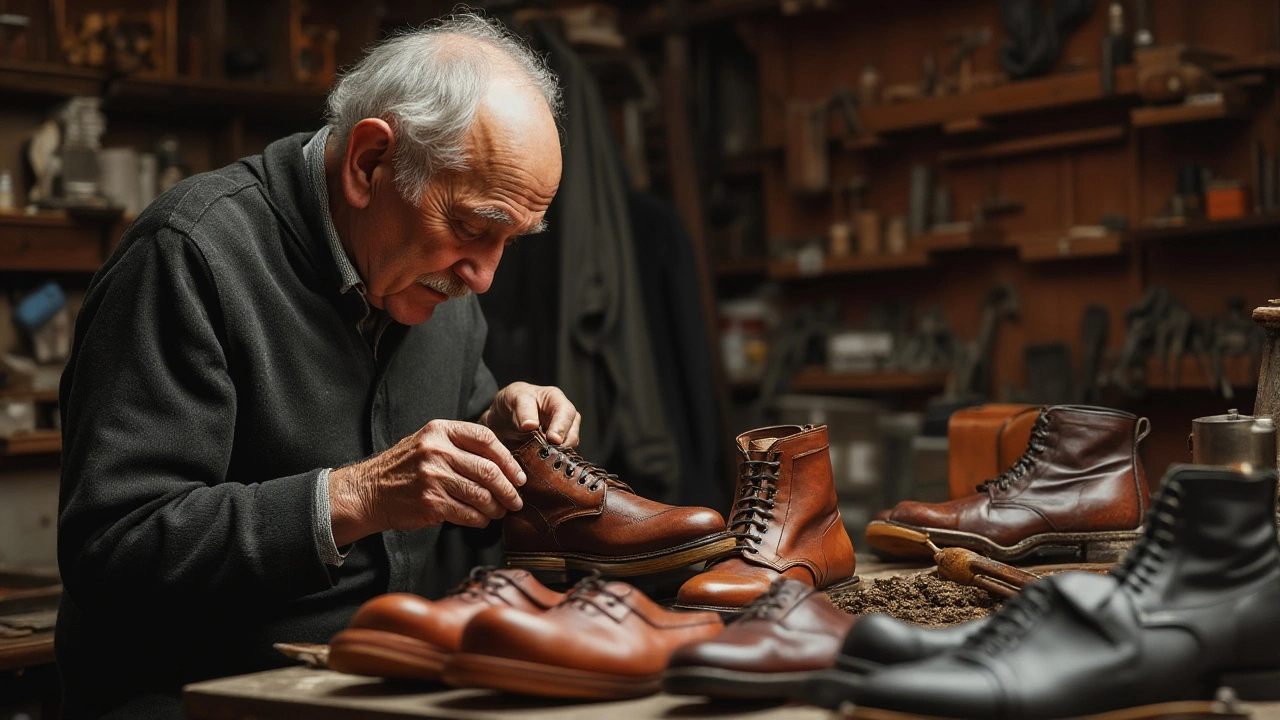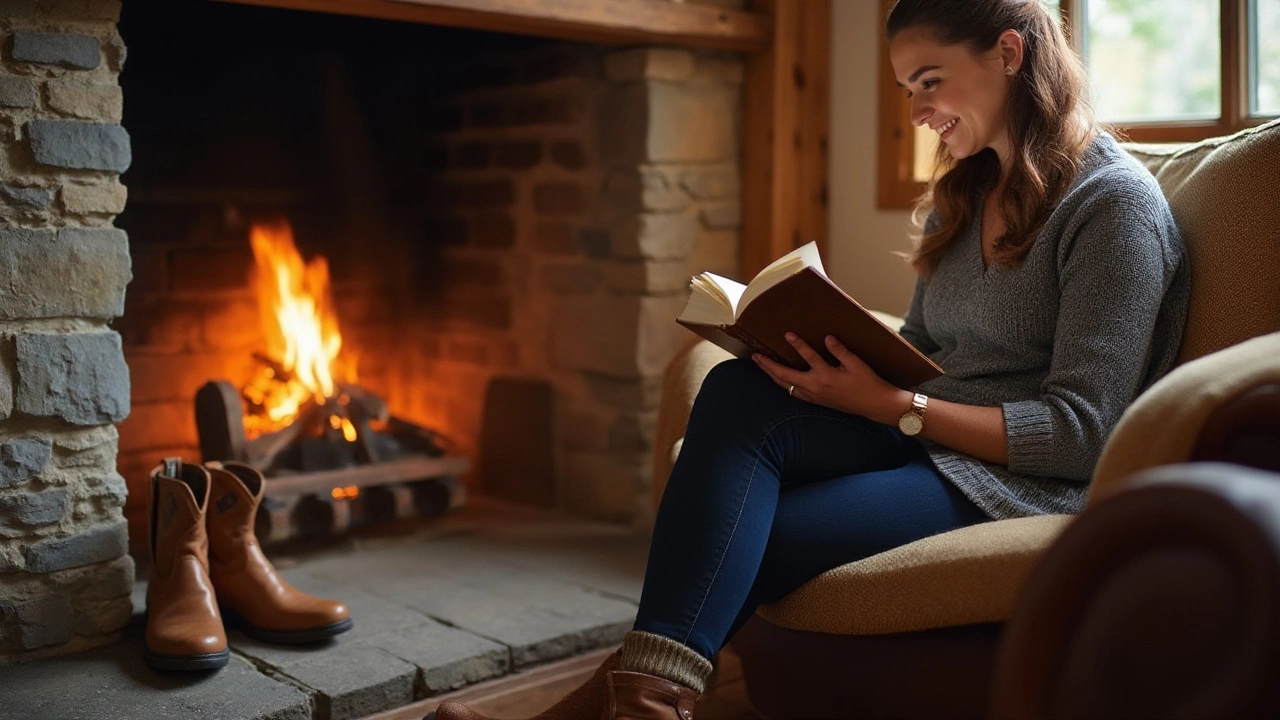Leather shoes are a beloved part of many Irish wardrobes, known for their style and durability. However, if you've ever slipped on a new pair only to find each step causing more and more discomfort, you're not alone. Despite their popularity, leather shoes can often feel anything but cozy, especially in the distinct weather conditions of Ireland.
One might wonder why something so timeless and seemingly reliable can be a source of discomfort. The answer often lies in the very nature of leather itself—rigid at first, it requires time and care to soften and mold to one's feet. Couple this with Ireland's varied climate, from damp coastal air in Galway to the chilly winds sweeping over Dublin, and it's clear that comfort isn't always as straightforward as slipping them on.
- Understanding Leather and Its Limitations
- Impact of Ireland's Climate on Leather Shoes
- Tips for Making Leather Shoes Comfortable
- Choosing the Right Leather Shoe
Understanding Leather and Its Limitations
Leather, a material once treasured by our ancestors for its durability and warmth, continues to be a favorite in the fashion industry for its timeless aesthetic and resilience. Delving into why leather shoes may sometimes be uncomfortable requires an understanding of leather’s inherent properties. This material, while beautiful and functional, begins its life quite differently from the soft and supple guise it eventually adopts. Initially, leather is a stiff, sometimes unforgiving material, especially when crafted into footwear. This rigidity is primarily due to the tightly-knit fibers found within raw hides, which are meticulously treated and tanned to transform them into something wearable.
The tanning process, a well-guarded craft dating back thousands of years, aims to prevent the decomposition of the hide while improving its tactile qualities. However, even with modern advancements making the leather softer and more pliable over time, the initial break-in period for a new pair of leather shoes can be notably uncomfortable. It’s worth mentioning that several types of leather exist, each possessing unique attributes. Full-grain leather, for example, is celebrated for its durability and is often considered the highest quality due to its natural surface. In contrast, corrected-grain leather, while less expensive, undergoes more processing which can affect its breathability and pliability.
In the context of Irish fashion, where weather patterns can be as unpredictable as the hills that define the landscape, the limitations of leather are further tested. Moisture, often abundant in Ireland, can lead to leather stiffening, causing further discomfort. Regardless of how carefully one cares for their footwear, exposure to dampness can result into stiffness, making the shoes feel less accommodating to feet shaped for movement rather than molding. As leather reacts to the elements, it requires dedicated care - a practice involving regular conditioning to maintain its suppleness and water resistance.
According to a study published in the Journal of Footwear Science, "While leather offers unique advantages in breathability and aesthetics, its initial stiffness is a commonly reported barrier to comfort, particularly noted in climatic regions with high humidity."
Understanding these properties and limitations can reshape how we approach buying and caring for leather shoes. Simply put, the material needs time to adapt to the contours of its owner’s feet, benefiting from gradual wear rather than abrupt, prolonged use. While the bespoke quality of leather grants it an allure few materials can match, it’s a relationship that demands patience and knowledge. For those in Ireland evaluating their leather footwear, considering the moisture levels and how they impact leather can be transformational. Investing in a quality leather conditioner and waterproofing spray may be an effort worth undertaking to ensure that footwear tips culminate in both style and comfort.

Impact of Ireland's Climate on Leather Shoes
In Ireland, the weather can be famously unpredictable, a fact every seasoned resident is well acquainted with. This climate variability can have significant effects on your cherished pair of leather shoes. The frequent rain showers and often damp atmosphere can take their toll, compelling leather to behave in a way that might feel somewhat unsavory to your feet. Leather, being a natural material, has a porous quality that allows it to absorb moisture; this is particularly relevant in the lush, rain-prone landscapes of the Emerald Isle. As leather absorbs water, it can swell and then contract as it dries, leading to a stiffened texture which might initially exacerbate discomfort. The moist environment can also lead to the leather not fully drying out, fostering conditions that make the shoes feel less breathable, leaving feet feeling clammy over prolonged periods.
Aside from the wetness, the temperature swings found on an Irish autumn day also need consideration. One moment you may be strolling along Dublin's bustling Grafton Street under clear skies, only to find a sudden cold breeze sweeping in from the River Liffey, making temperatures drop unexpectedly. These changes might not affect your woolen jumper, but for leather shoes, it's a different story. Leather's response to temperature variations is to either relax or stiffen, sometimes causing the fit to alter as you wear the shoes through varying conditions. While a snug fit is normally desirable, a too-tight shoe clamping down with each chilly breath of wind doesn't make for a pleasant walking experience.
"Leather shoes must be allowed to breathe in the Irish climate," says Sean O'Leary, a seasoned cobbler from County Cork, "They need care tailored to these conditions; a good polish and regular airing can change discomfort into joy."
Moreover, the terrain itself can't be ignored. Whether you’re hiking through the rugged landscapes of Connemara or merely negotiating the cobblestone streets in Kilkenny, the surfaces on which you tread in Ireland are often irregular. This puts extra strain on leather shoes, which may already be stretched or warped by water exposure, having to conform to unforgiving surface shifts. Unlike synthetic materials, leather isn’t as elastic, thus it has a harder time effortlessly accommodating this unique pressure. Your toes might feel the pinch as a result, hinting yet again at why discomfort might rear its head more persistently here versus drier climes.
All these factors together suggest the importance of thoughtful shoe choice and care. Leather shoes are undoubtedly a beautiful, timeless selection, but as with many traditional things, they require a touch of patience and insight to bring out the best in a reliably wet and ever-changing climate like Ireland's. Bearing these considerations in mind can help transform the way your favorite footwear accompanies you on Ireland's wondrous journeys, lessening those pesky twinges once thought innate to the shoe itself.

Tips for Making Leather Shoes Comfortable
Irish people know that leather shoes, while exquisite, can sometimes feel more like an art project than footwear. The process of turning them from a rigid shell into a perfect fit requires understanding and persistence. Here are some methods to nip discomfort in the bud and turn that squeaky new pair into a trusted companion. First and foremost, remember the critical rule of break-in periods. Wearing your new leather shoes around the house before taking them on the street is essential, especially given the unpredictability of Irish weather. Spending short bursts of time in them, coupled with gentle flexing and bending, helps the leather accommodate to your foot shape.
For those really stubborn pairs, consider stretching techniques. Professional cobblers in cities like Dublin or Cork offer stretching services that can add vital millimeters of relief. Investing in a wooden shoe stretcher can also do wonders, applying pressure in uncomfortable spots, easing those pressure points—just add a little patience. To further help, there's the classic trick of applying heat. Using a hairdryer can soften the leather. With socks on, target tight areas, and bend your foot to encourage the shoe to adapt. But do it cautiously, as overheating might cause more harm than good.
Moisture matters too, especially in wet climates. Applying a leather conditioner not only keeps shoes flexible but also offers protection against Dublin's notorious drizzle. Products containing natural oils help maintain a soft texture—preventing cracks, which can often lead to bruising. Use these conditioners regularly, particularly before and after exposure to harsh weather conditions. Aim for a couple of times a month, or whenever the leather begins to feel dry. And if blisters are your nemesis, resist the urge to go barefoot. High-quality moisture-wicking socks can make all the difference by providing cushioning and reducing friction. These accessories ensure healthy blister-free feet, as no one wants to hobble halfway through a day in Galway.
Moreover, consider the in-soles. Cork-footbeds, a nod to the beloved Irish city, are known for adjusting to individual contours. They’re like a good secret—tucked away but life-changing when found. A well-chosen insole can transform your shoes from painful to pleasurable. There's no shame in using gel pads or insert options specifically designed for various problem areas. They can distribute your weight evenly, absorbing the impact on unforgiving cobblestones found across many historic Irish towns. Lastly, look towards some ancient wisdom, as well. Leather has been around for centuries, and for good reason. As the poet William Butler Yeats once said about comfort and style, "Style is a fraud, a mere show. Nothing but a fleeting shadow." In the world of leather shoes, there's much truth in his words—real style stems from comfort first.
Bear in mind, ensuring comfort doesn’t just make getting around our island more pleasant; it lets you focus more on your day’s treasures than the pain in your step. Let each step in your leather shoes carry confidence, whether you're climbing the peaks of Kerry or just strolling through your local park.

Choosing the Right Leather Shoe
Finding the ideal leather shoe is much like embarking on a journey; it requires patience, attention, and sometimes a little help from knowledgeable locals or seasoned shopkeepers. When considering a pair of leather shoes in Ireland, it's important to think beyond just aesthetics. The shoe must also offer a balance between fit, flexibility, and function, particularly given Ireland's sometimes unpredictable weather patterns.
One of the first aspects to consider is the type of leather used. Not all leather is created equal, and the variety can greatly influence comfort levels. For instance, full-grain leather, known for its durability and aging charm, might initially feel stiff but softens beautifully over time. In contrast, nubuck or suede options can offer immediate comfort, though they might lack in longevity when exposed to heavy moisture. An intriguing case study revolved around a Galway shoemaker who shared insights in a local publication, noting "When it comes to Irish weather, a well-treated full-grain leather shoe is likely to withstand the elements with much more grace than its softer counterparts.”
Next, consider how the shoe is constructed. Goodyear-welted shoes, for instance, offer an extra layer of protection from moisture, which can be a blessing during the frequent drizzles experienced along Ireland's west coast. This method involves a strip of leather running along the perimeter of the shoe, making them not only more durable but also easier to resole, a crucial factor in extending the shoe's lifespan. However, this might mean a longer break-in period, something worth bearing in mind if you're planning a hike along the Ring of Kerry or an urban tour in Cork.
When it comes to fit, the right size should feel snug but not tight, as leather naturally expands over time. It's often recommended to try shoes on in the late afternoon when your feet are at their widest. Additionally, some stores in Dublin even offer a scanning technology to provide precise measurements of your feet, ensuring the chosen pair fits like a glove. The role of socks is not to be underestimated either; wearing well-fitted socks during shoe trials can provide a better sense of how the shoe will wear day to day.
Don't shy away from asking the retailer about the shoe's specific features or any aftercare products that might enhance longevity and comfort. Many stores in Ireland stock leather conditioners and water-repellent sprays, which help protect against the famous Irish rain while also keeping the leather nourished. Another pro tip is to break in your new leather shoes gradually; wear them indoors for short bursts before taking them out for longer excursions. This can help prevent unnecessary blisters and discomfort. Finally, while trends may come and go, a classic style tends to offer more versatility across various outfits and occasions, making for a wise investment in any wardrobe.
A famous quote by a renowned cobbler from Kilkenny reads, "In the world of leather shoes, patience is your greatest ally. Allow your shoes to earn their place, and they shall reward you with grace and comfort in every step.”
